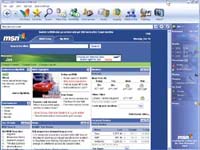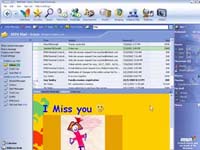REDMOND, Wash., Oct. 23, 2002 — Michael McKinnor’s 13- and 14-year-old sons weren’t exactly happy when they heard their dad would be monitoring their online activities, but according to McKinnor, they’re warming up to it.
“I don’t tell them what they can and can’t look at on the Web, but MSN gives me a way to intervene if I need to,”
says McKinnor, a mechanic in Lawndale, Calif. Like families everywhere that are connected to the Web, the McKinnors face decisions about how to protect their children from adult-oriented content.
“If I see a site on the weekly activity report they’re not ready for, I can ask them what they thought about it and go from there,”
the father says.

My MSN home page for MSN8
As participants in one of many Microsoft programs that gather direct input from everyday PC users, the McKinnors have themselves, in part, to thank for this new feature in MSN 8, which launches this week with gala festivities in New York City. In fact, behind practically every new feature in Microsoft’s Internet service, from the advanced communication and browsing tools to online safety features for children, is data that comes directly from consumers.
“In the past, product development teams tended to be isolated from the world at large, relying on market data and drawing their own conclusions about what their products should entail,”
says David Cheng, MSN program manager at Microsoft.
“With the release of MSN 8, because of our emphasis on direct input from consumers, we’ve created not just a product that we think people want, but the product they asked for.”
Anthropology Meets Software Design
MSN 8 represents the first intensive use of anthropological study to enhance the MSN client and bring the customer’s voice into the product development cycle. More traditional market research relies heavily on large-scale surveys to identify population-level behavior patterns or focus groups to understand how people respond to specific product initiatives. Anthropology takes a different approach, focusing on the context of individuals’ lives, to understand their goals and ideas about their world.
“Field studies open our eyes to how regular people, unguided, use their PC and the Web, as well as specific products and features we design,”
Cheng says.
“We use the resulting information to guide us in the redesign and enhancement of our products to reflect how people want to use them.”
Like usability engineers, who test product features with volunteers in a laboratory setting, anthropologists have to make a connection between the product Microsoft is designing and what the customer needs and wants. But while a usability engineer is familiar with a feature’s capabilities and justification, anthropologists intentionally avoid bringing the product perspective with them into the field. As a result, the data gathered from the various methods of research provides a more holistic view of customers, their needs, and the tasks they’re trying to accomplish in their everyday lives.
“When we go into a home, we don’t have product features in mind,”
says Anne Cohen Kiel, a design anthropologist at Microsoft.
“After observing the native point of view, as it’s called in classic anthropology, our job is to translate our findings back into features and design objectives. Anthropological study offers a real-world depth that other channels don’t get at, and it’s the tight collaboration of anthropologists with the rest of the development team – usability engineers, market researchers, product designers and others – that makes our products so fantastic.”
Online Safety That Works for Families

MSN Mail preview pane
During two years of field research for Microsoft, Kiel’s subjects, including the McKinnors, repeatedly brought up their concern about Internet safety for children. They wanted to prevent their children from being exposed to pornography and inappropriate e-mail, and weren’t finding services or technology that addressed the problems adequately.
“People didn’t want their kids to have this open access to the world — it scared them,”
Kiel says.
“They were afraid that this open access would allow people to intrude on their life in some way, psychologically or physically. Furthermore, they wanted to know where their children had been on the Web, and how long they’d been there. This came up over and over in different kinds of conversations.”
Back at Microsoft, product design for MSN 8 parental controls was focusing on prevention, allowing parents to block inappropriate content and fine-tune the amount of protection on a feature-by-feature basis. But as data flowed in from the anthropology fieldwork, MSN 8 program managers decided to take a step back — in the middle of the development cycle — and adjust their strategy to incorporate monitoring features into the parental controls.
“The monitoring aspect of our parental controls, in addition to the flexibility of settings, differentiates MSN 8 from our competitors,”
Cheng says.
“It’s a great example of how, from a program management and feature design standpoint, we took the ethnographic data and found an additional way to approach this MSN feature.”
McKinnor was pleased to see that his feedback had been heard.
“Some of the things I said I would like to see, nearly a year ago, actually came to fruition in MSN 8 — the activity report, for instance,”
the father says.
“Now the boys are more apt to speak to me about Web content they have a concern about or interest in, before I find out. It’s pushing us in the same direction, you could say. It’s a tool we can use to generate conversation.”
Smart Technology to Squelch Spam
The new spam filter built into MSN 8 incorporates direct consumer input in two additional ways. Developers leveraged data from existing MSN Mail users as the foundation of the filter’s built-in knowledge, and then created a mechanism for MSN 8 subscribers to
“train”
the filter to become more responsive to their own preferences over time.
MSN Mail, formerly MSN Hotmail, offers everyone a certain amount of protection from spam, or unsolicited commercial e-mail, at the server level. However, MSN 8 product designers wanted to do better, so they turned to the Machine Learning Group within Microsoft Research (MSR), the technology research branch of Microsoft, to design a junk-mail filter at the desktop level, to greatly reduce the amount of junk mail that lands in people’s MSN Mail inboxes.
The MSN 8 spam filter represents one of the biggest, most visible examples of machine learning being used in a product at Microsoft, according to Robert Rounthwaite, research software development engineer at MSR. With machine learning, a computer application is trained to understand the characteristics of a set of sample data well enough to separate it into categories. In this case, the application has to distinguish two categories of e-mail — spam and
“nonspam.”
When this is achieved, an application can be built around that knowledge, enabling the system to take action on the unsolicited e-mail.
“The tool has to be extremely careful with e-mail, because it’s such a valuable resource for people,”
Rounthwaite says.
“From a consumer’s standpoint, e-mail is starting to become an unpleasant experience as a result of spam. Our objective is to eliminate much of that unpleasantness without adding a new task or responsibility that users have to worry about.”
Leave it to researchers and programmers to build the technology, but the core knowledge built into the MSN 8 spam filter came straight from MSN Mail users, and the thousands of e-mail messages they contributed for this development effort.
“We didn’t sit down and make any choices about what was and wasn’t spam,”
Rounthwaite says.
“Volunteers agreed to contribute their e-mail, sorted by what they had and hadn’t chosen to receive. Our machine learning technology enabled the filter to learn from the decisions those people had made. So the practical logic of identifying spam came from the users on up. Microsoft Research built a really smart tool, but MSN Mail users trained it.”
Because the filter is intelligent, MSN subscribers can continue to
“educate”
their filter, to fine-tune how the filter classifies junk mail. By selecting an unwanted message that passes through to the inbox, users can click the Junk button on the MSN Mail toolbar to add the message’s attributes to the filter. Likewise, a Not Junk button allows users to reclassify messages incorrectly routed to the Junk Mail folder. The filter also includes a
“safe list”
which, starting with a person’s e-mail address book, consists of trusted e-mail senders. Messages from senders on this list are passed through to the Inbox regardless of their other attributes.
“Because of our foundation in real-world data, both in the original training of the technology and through ongoing input from each MSN 8 subscriber, we have created one of the best spam filtering capabilities in place today,”
Rounthwaite says.
“In essence, as you give it more information about the world, it can react to the world more effectively.”
And that’s just the point with MSN 8, says anthropologist Kiel.
“Thousands of hours of research have been distilled into this product, with one fundamental objective: to create software that we believe delivers real-world value to the millions of MSN subscribers — software that is, in the end, simply useful.”




